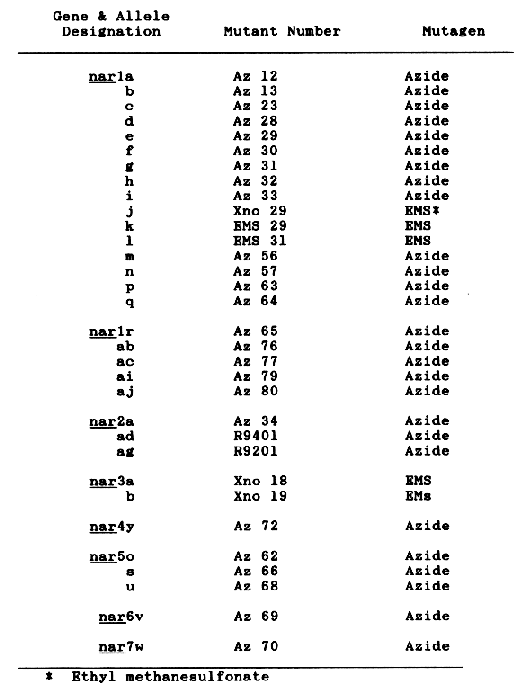

Thirty-two nitrate reductase (NR) deficient mutants have been characterized by genetic complementation testing. These mutants fall into seven complementation groups designated nar1 through nar7. The gene nar codes for the NADH-NR apoprotein. All of the alleles at this locus are NADH-NR deficient but have NAD(P)H-NR activity. The measurable NAD(P)H-NR activity is only 10-20% of the wild type NADH-NR activity, but appears to be sufficient to permit essentially normal growth of these mutants under field conditions in Pullman, Washington. The mutant Xno 29 is an exception in that it is not able to grow to maturity under our field conditions, even though it has greater NR activity than other nar1 alleles. The gene nar7 codes for the NAD(P)H-NR apoprotein. The only characterized allele, nar7w, is normal in all respects except that it lacks the NAD(P)H-NR activity found in the seedling roots of the wild-type control (c.v. Steptoe). The genes nar2 through 6 code for various molybdenum cofactor functions. All alleles of these loci are deficient in xanthine dehydrogenase activity in addition to the nitrate reductase deficiency. The alleles nar2ad, 2ag, nar3a, 3b, nar4y, and nar6v are lethal under field conditions and must be maintained as heterozygotes. The other alleles, are viable but nar2a shows definite light green phenotype under our field conditions.
The gene and allele designation, mutant number and mutagen used to induce each mutant are shown in Table 1. The mutants Xno 18, 19, and 29 were obtained from Dr. V. K. Shumny (Academy of Sciences, Institute of Cytology and Genetics, Novosibirsk 90, USSR; Tokarev and Shumny, 1977; Shumny and Tokarev, 1981). The mutants R9401 and R9201 were obtained from Dr. S. W. J. Bright (present address: ICI International Seeds Business, Jealott's Hill Research Station, Bracknell, Berks., RG12 6EY, United Kingdom; Bright et al., 1983; Bright, personal communications). The remaining mutants were induced and selected in our laboratory. Some have been previously described (Kleinhofs et al., 1985).

Literature Cited
Bright, S. W. J., P. B. Norbury, J. Franklin, D. W. Kirk, and J. L. Wray. 1983 A conditional-lethal cnx-type nitrate reductase-deficient barley mutant. Mol. Gen. Genet. 189-240-244.
Kleinhofs, A., R. L. Warner, and K. R. Narayanan. 1985 Current progress towards an understanding of the genetics and molecular biology of nitrate reductase in higher plants. In: B. J. Miflin, ed., Oxford Surveys of Plant Molecular and Cell Biology, Vol. 2. Oxford University Press, Oxford, England. pp. 91-121.
Shumny, V. K. and B. I. Tokarev. 1981 Genetic control of nitrate reductase activity in barley. In: M. J. C. Asher, R. P. Ellis, A. M. Hayter, and R. N. H. Whitehouse, eds., Barley Genetics IV. Edinburgh. pp. 881-885.
Tokarev, B. I. and V. K. Shumny. 1977 Detection of barley mutants with low level of nitrate reductase activity after the seed treatment with ethylmethanesulphonate. Genetika (Moskva) 13:2097-2103.